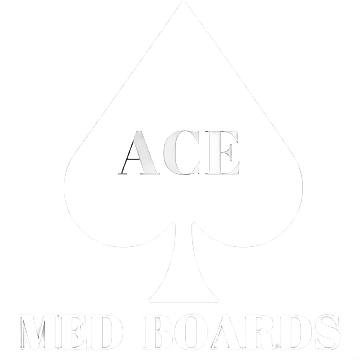The MCAT is a test of endurance, critical thinking, and, most importantly, strategic studying. With a vast ocean of scientific concepts to cover, from organic chemistry reactions to psychological theories, it's easy to feel overwhelmed. The key to conquering this exam isn't necessarily studying more; it's about studying smarter. This is where the power of focusing on mcat high yield topics comes into play. These are the concepts, principles, and problem-solving skills that the AAMC tests repeatedly, forming the backbone of the exam across all four sections.
By concentrating your efforts on these critical areas, you ensure that every hour of study delivers the maximum return on your score. Mastering high-yield content builds a strong foundation, allowing you to more easily connect disparate concepts and tackle complex, passage-based questions with confidence. This focused approach streamlines your preparation, reduces wasted effort on obscure details, and directly translates to a higher score. As you focus on mastering high-yield topics for the MCAT, it's also important to understand the broader context of successful academic pursuits, including adhering to strong academic integrity guidelines throughout your pre-med journey.
This guide cuts through the noise. We will provide a curated roundup of the most essential, frequently tested topics on the MCAT, organized by section. For each topic, you'll find a breakdown of what you need to know, why it's so important, and actionable advice on how to master it efficiently. Prepare to transform your study plan from a scattered review into a targeted, effective strategy designed for success.
1. Amino Acids and Protein Structure
Amino acids are the fundamental building blocks of life, and mastering them is non-negotiable for MCAT success. This topic is a cornerstone of the Biological and Biochemical Foundations of Living Systems section. It's not just about memorizing the 20 standard amino acids; it's about deeply understanding their properties and how these properties dictate protein structure and function, which is why it consistently ranks among the most crucial MCAT high yield topics.
A firm grasp of amino acid classification (hydrophobic, hydrophilic, acidic, basic), their one and three-letter codes, and their structures is the first step. This knowledge directly translates to understanding protein folding, enzyme active sites, and the molecular basis of diseases.
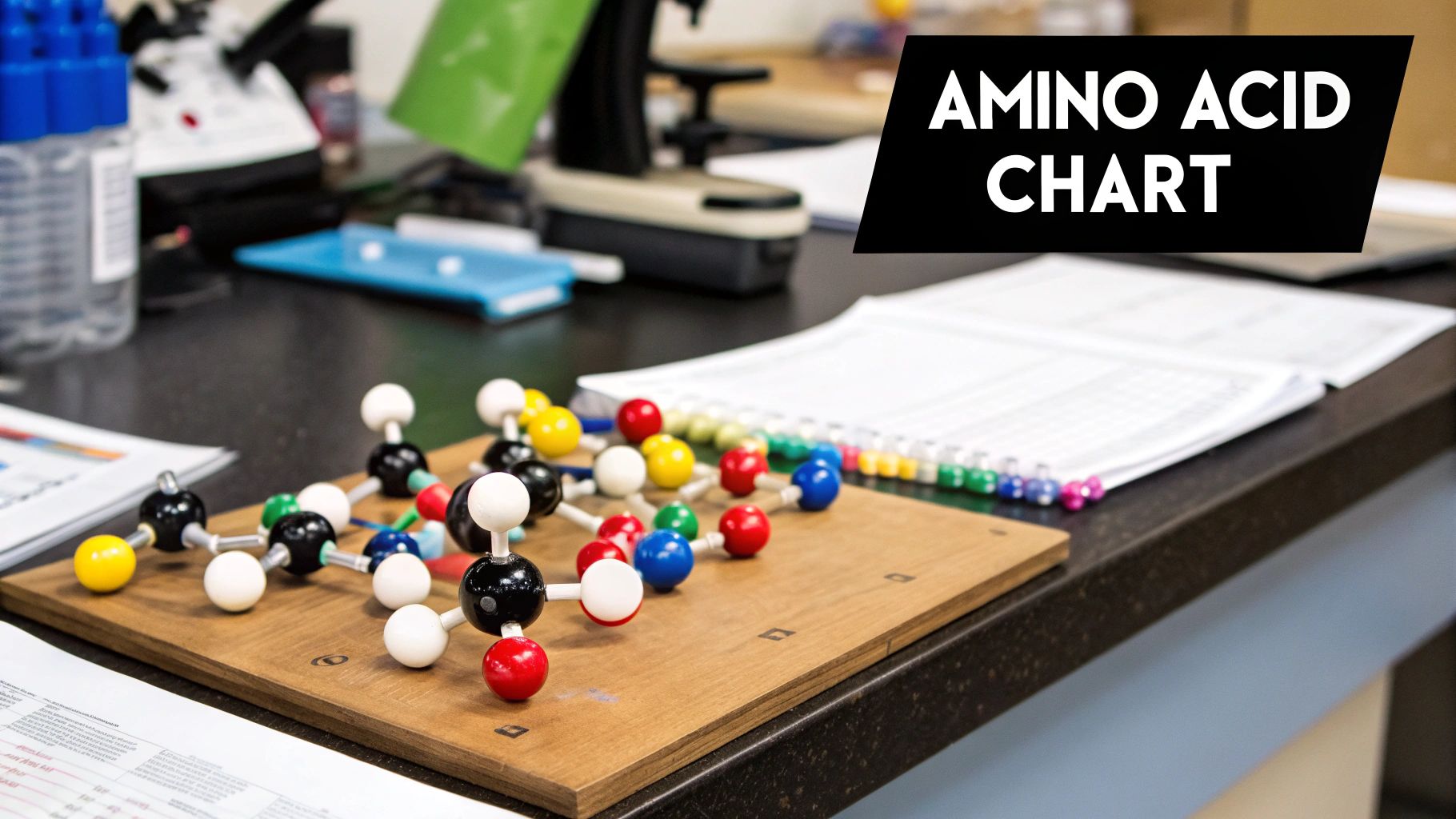
Why It's a High-Yield Topic
Understanding this topic is essential because it underpins countless other biological concepts tested on the MCAT. For instance, a single amino acid substitution (glutamic acid to valine) in hemoglobin leads to sickle cell disease, a classic example the AAMC loves to test. Similarly, the specific arrangement of amino acids in an enzyme's active site determines its substrate specificity, a key concept in enzyme kinetics. Your ability to connect an amino acid’s R-group to its role within a larger protein structure is a skill that will be tested repeatedly.
Actionable Study Strategies
To integrate this topic effectively, move beyond simple flashcards.
- Categorize and Conquer: Use mnemonics to group the amino acids. A popular one for the nonpolar, hydrophobic group is "FAMILY VW" (Phenylalanine, Alanine, Methionine, Isoleucine, Leucine, Tyrosine, Valine, Tryptophan). Create similar ones for other groups.
- Draw, Don't Just Read: Actively practice drawing each amino acid from memory. This reinforces your knowledge of their structures, pKa values, and titration curves far better than passive review.
- Connect to Function: For every amino acid, ask yourself: "Where would I find this in a protein?" Hydrophobic residues like valine and leucine are typically buried in the protein core, while hydrophilic residues like serine and lysine are found on the surface, interacting with water. Proline, the "helix breaker," disrupts secondary structures.
- Visualize in 3D: Use free tools like PyMOL or Jmol to explore protein structures like collagen or myoglobin. Seeing how amino acids orient themselves in three-dimensional space provides context that a textbook diagram cannot.
2. Enzyme Kinetics and Inhibition
Enzyme kinetics is the study of the rates at which enzymes catalyze chemical reactions. A deep understanding of this topic is critical for the MCAT, as it forms the basis for much of biochemistry and pharmacology. It involves concepts like Michaelis-Menten kinetics, the significance of Vmax and Km, and the various ways enzymatic activity can be modulated through inhibition, making it one of the most essential MCAT high yield topics.
Mastering this area means you can predict how metabolic pathways are controlled and how drugs function. The MCAT frequently tests these principles through graphs, experimental data, and passage-based questions, requiring you to interpret data, not just recall facts. For example, understanding how a statin drug competitively inhibits HMG-CoA reductase is a classic application of these principles.
This infographic breaks down the core process of enzyme catalysis and highlights where key kinetic parameters and inhibitors exert their effects.
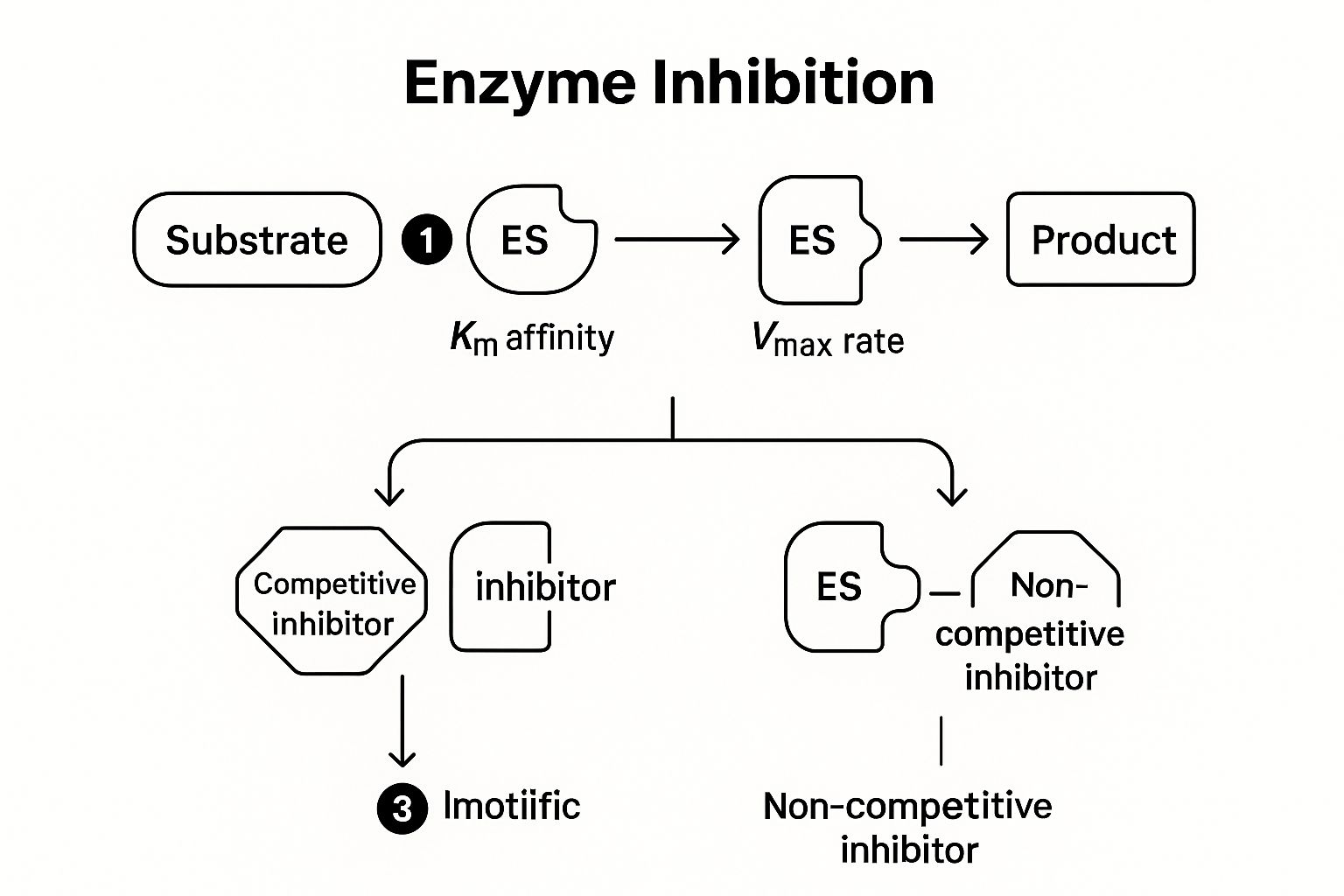
The visualization clearly shows how Km relates to substrate binding affinity, while Vmax is determined by the catalytic turnover rate of the enzyme-substrate complex.
Why It's a High-Yield Topic
Enzyme kinetics is a high-yield topic because it is fundamentally quantitative and conceptual, lending itself perfectly to the MCAT's problem-solving format. You will be expected to analyze Lineweaver-Burk plots to determine the type of inhibition and calculate changes in Km and Vmax. These concepts are directly applicable to understanding drug mechanisms, such as how aspirin irreversibly inhibits COX enzymes or how penicillin disrupts bacterial cell wall synthesis. The AAMC loves to test your ability to connect a change in a kinetic graph to a specific molecular interaction.
Actionable Study Strategies
To truly master enzyme kinetics, you must go beyond rote memorization of equations.
- Master the Graphs: Practice interpreting Michaelis-Menten and Lineweaver-Burk plots until they become second nature. For each inhibitor type (competitive, non-competitive, uncompetitive), be able to draw how the plot changes and explain why it changes in terms of Km and Vmax.
- Think in Terms of Affinity and Rate: Frame your understanding around two key questions: How does this inhibitor affect the enzyme's affinity for its substrate (Km)? How does it affect the maximum rate of the reaction (Vmax)? This simplifies the logic.
- Connect to Allostery: Extend your knowledge to allosteric regulation. Understand cooperativity, as seen in hemoglobin's oxygen binding, and how allosteric activators and inhibitors shift the enzyme between its high-affinity (R) and low-affinity (T) states.
- Use Real-World Examples: Associate each inhibition type with a real drug or biological process. Competitive inhibition links to statins, irreversible to aspirin, and allosteric regulation to metabolic feedback loops. For a comprehensive approach, see how this topic fits into a larger MCAT study plan.
3. Cellular Respiration and ATP Production
Cellular respiration is the metabolic engine of the cell, converting biochemical energy from nutrients into adenosine triphosphate (ATP). A deep understanding of glycolysis, the citric acid cycle, and the electron transport chain is absolutely critical for the MCAT. This topic is not just about memorizing steps; it’s about understanding the regulation, products, and interconnectedness of these pathways, making it one of the most tested mcat high yield topics.
A solid foundation in cellular respiration allows you to answer questions spanning from basic biochemistry to complex systemic physiology. The AAMC expects you to know the net energy yields, key regulatory enzymes, and the cellular locations for each stage of this intricate process.
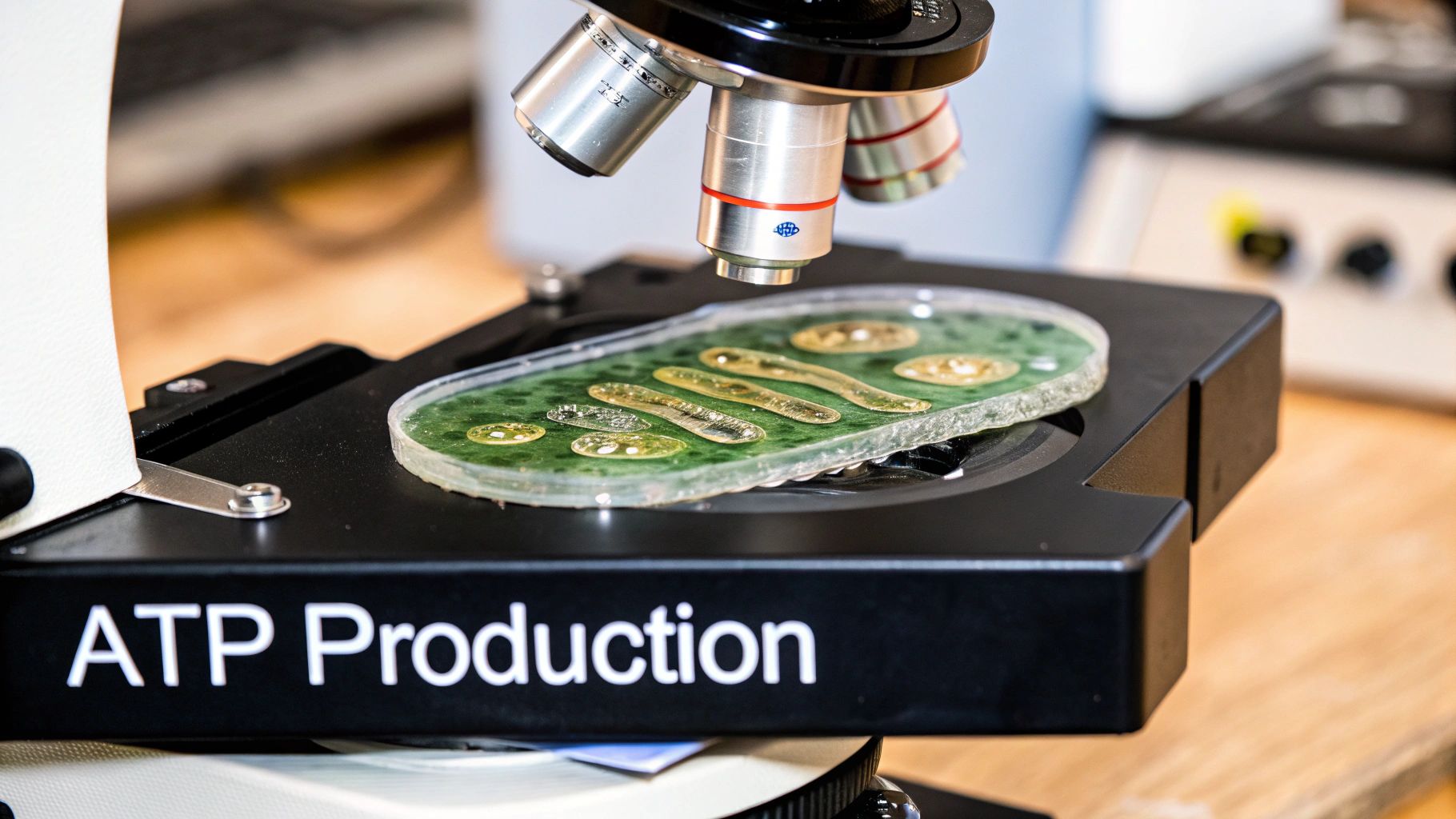
Why It's a High-Yield Topic
This metabolic sequence is central to life and, consequently, to the MCAT. It directly connects to physiology, endocrinology, and pathophysiology. For example, questions may test your knowledge of how cyanide poisoning halts the electron transport chain, leading to rapid ATP depletion. You may also see scenarios involving exercise physiology, where you must explain the switch to anaerobic glycolysis and the resulting lactate production, or how metabolic disorders like diabetes impact glucose processing and energy balance.
Actionable Study Strategies
Go beyond rote memorization to truly master these pathways.
- Focus on the Flow: Instead of memorizing every single molecule, track the flow of carbons and electrons. Start with a 6-carbon glucose and follow it as it’s split, oxidized, and eventually released as CO2. Similarly, track the journey of electrons from NADH and FADH2 to the final electron acceptor, oxygen.
- Know the Checkpoints: Identify and understand the key regulatory enzymes for each pathway, such as phosphofructokinase-1 (PFK-1) in glycolysis or isocitrate dehydrogenase in the citric acid cycle. Know what activates and inhibits them, as this is a frequent source of MCAT questions.
- Draw It Out: On a blank sheet of paper, draw the complete pathways from memory. Include reactants, products, enzymes, and net ATP/NADH/FADH2 yields for each major step. This active recall method is far more effective than passive reading.
- Connect to Anaerobic Conditions: Understand what happens when oxygen is not available. Trace the fate of pyruvate to lactate in animals or ethanol in yeast, and explain why this process is necessary to regenerate NAD+ for glycolysis to continue.
4. DNA Replication and Repair
The mechanisms that cells use to copy and maintain their genetic blueprint are fundamental to life, making DNA replication and repair a centerpiece of the MCAT's biological sciences sections. A deep understanding of this topic is crucial, as it explains the basis of heredity, genetic disease, and cancer. It's not enough to list the enzymes involved; you must understand their specific roles, the sequence of events, and the consequences of failure, solidifying its status as one of the most essential mcat high yield topics.
This area covers the semi-conservative replication process, detailing the functions of key players like helicase, primase, DNA polymerases, and ligase. You must be able to distinguish between leading and lagging strand synthesis, explain the necessity of Okazaki fragments, and grasp how repair mechanisms like mismatch repair and nucleotide excision repair safeguard the genome's integrity.
Why It's a High-Yield Topic
Questions on this topic directly test your ability to think like a scientist. You'll be asked to predict the outcome of an experiment where a key enzyme is inhibited or a repair pathway is defective. For example, understanding that DNA polymerase can only add nucleotides to a free 3'-OH end explains the need for an RNA primer and the discontinuous nature of the lagging strand. The AAMC frequently links these concepts to practical applications, such as the mechanism of certain antibiotics that target bacterial DNA gyrase or how defects in DNA repair proteins (like BRCA1/2) dramatically increase cancer risk.
Actionable Study Strategies
To master the intricacies of DNA processes, you need to go beyond rote memorization.
- Focus on Directionality: Constantly reinforce the 5' to 3' rule. Remember that DNA polymerase synthesizes in the 5' to 3' direction while reading the template strand in the 3' to 5' direction. Draw out the replication fork and label the directions of both the template and newly synthesized strands.
- Create "What If" Scenarios: Ask yourself what would happen if a specific enzyme failed. For instance, "What if DNA ligase was non-functional?" The answer: Okazaki fragments on the lagging strand would never be joined, leading to a fragmented chromosome. This active-recall method prepares you for application-based questions.
- Connect to Lab Techniques: Relate DNA replication to the polymerase chain reaction (PCR). Both involve unwinding a DNA template, using primers, and synthesizing new strands with a polymerase. Understanding the natural process makes the lab technique much more intuitive.
- Link to the Bigger Picture: Connect replication and repair to other high-yield concepts. For example, telomere shortening during replication is a key aspect of cellular aging. Errors that escape repair mechanisms are the source of mutations, which drive evolution and can lead to genetic disorders.
5. Acid-Base Chemistry and Henderson-Hasselbalch
The principles of acid-base chemistry are woven into the fabric of the MCAT, appearing in both the Chemical and Physical Foundations and the Biological and Biochemical Foundations sections. Mastery of concepts like pH, pKa, buffers, and the Henderson-Hasselbalch equation is absolutely essential. This topic isn't just about abstract chemical reactions; it’s about understanding life’s delicate balance, making it one of the most practical and frequently tested MCAT high yield topics.
A deep understanding of this area allows you to predict how molecules like amino acids or drugs will behave in different physiological environments. It’s the key to unlocking complex processes, from the regulation of blood pH to the function of enzymes and the absorption of pharmaceuticals in the digestive tract.
Why It's a High-Yield Topic
Acid-base chemistry is a high-yield topic because it is the language of biological systems. The AAMC loves to test your ability to apply these principles to real-world physiological scenarios. For example, questions frequently involve the bicarbonate buffer system (H₂CO₃ / HCO₃⁻), which maintains blood pH within a narrow, life-sustaining range. You might be asked to predict how hyperventilation (exhaling excess CO₂) affects blood pH or how the ionization state of an amino acid's side chain changes as it moves from the stomach (pH ~2) to the small intestine (pH ~8).
Actionable Study Strategies
To truly master acid-base chemistry, you must go beyond rote memorization of equations.
- Master the Log-Math: The MCAT is a no-calculator exam, so you must be comfortable with logarithmic estimations. Practice estimating log(x) values quickly. Remember that log(1) = 0, log(10) = 1, and that log(3) is approximately 0.5. This skill is critical for Henderson-Hasselbalch calculations under pressure.
- Conceptualize the Equation: Don't just plug and chug. Understand what the Henderson-Hasselbalch equation tells you. Memorize that when the concentration of the conjugate base [A⁻] equals the concentration of the acid [HA], the pH of the solution is equal to the pKa. This is the point of maximum buffer capacity.
- Connect to Physiology: Always link chemical principles to biological function. Study the bicarbonate buffer system in detail. Understand how changes in respiration or metabolic processes create states of acidosis or alkalosis and how the body compensates.
- Titration Curve Fluency: Practice drawing and interpreting titration curves for strong acids/bases, weak acids/bases, and polyprotic acids like amino acids. Be able to identify the pKa values and the equivalence points and explain the chemical species present in each region of the curve.
6. Mendelian Genetics and Inheritance Patterns
From Punnett squares to pedigree analysis, the principles of classical genetics are a fundamental component of the MCAT. This topic covers the work of Gregor Mendel, including the laws of segregation and independent assortment, and extends into more complex inheritance patterns. Its application in predicting disease likelihood and understanding population-level genetics makes it one of the most consistently tested MCAT high yield topics.
A thorough understanding involves more than just filling out a Punnett square. You must be able to interpret pedigrees, differentiate between autosomal and sex-linked traits, and apply concepts like codominance, incomplete dominance, and penetrance. This knowledge is crucial for answering passage-based questions that describe family histories of genetic disorders.
Why It's a High-Yield Topic
The AAMC uses genetics to test your ability to apply logical reasoning and quantitative skills to biological scenarios. Questions often require you to deduce genotypes from observed phenotypes, calculate the probability of offspring inheriting a condition, or analyze population data using the Hardy-Weinberg equilibrium. For instance, you could be asked to determine the inheritance pattern of a rare disease from a pedigree chart or calculate the frequency of carriers for an autosomal recessive condition like sickle cell anemia. Mastering these skills is essential for tackling some of the most challenging problems on the Bio/Biochem section.
Actionable Study Strategies
To excel in this area, focus on problem-solving and conceptual clarity.
- Systematize Your Approach: Before starting any genetics problem, clearly define the alleles (e.g., A = dominant allele, a = recessive allele). Use a systematic Punnett square for simple crosses and a probability-based approach (the product rule) for more complex multi-gene crosses.
- Practice with Pedigrees: Actively analyze pedigree charts. For each one, try to determine the mode of inheritance: Is it dominant or recessive? Autosomal or X-linked? Look for key clues, such as traits skipping a generation (recessive) or being passed from father to all daughters (X-linked dominant).
- Master Hardy-Weinberg: Don't just memorize the equations (p + q = 1 and p² + 2pq + q² = 1). Understand the five conditions required for equilibrium and how to use the equations to calculate allele and genotype frequencies. Practice problems until these calculations become second nature.
- Connect Concepts: Differentiate clearly between related but distinct concepts. For example, understand that codominance (e.g., ABO blood types) means both alleles are expressed, while incomplete dominance means a blended phenotype appears. Linking these definitions to concrete examples is key to improving your MCAT score.
7. Thermodynamics and Free Energy
The principles of thermodynamics govern every energy transaction in a living organism, from cellular respiration to protein folding. This topic, particularly Gibbs free energy, is a major component of both the Chemical and Physical Foundations of Biological Systems and the Biological and Biochemical Foundations of Living Systems sections. It’s not just about equations; it's about understanding the "why" behind biological processes, making it one of the most fundamental MCAT high yield topics.
A solid understanding of enthalpy (ΔH), entropy (ΔS), and Gibbs free energy (ΔG) allows you to predict whether a reaction will occur spontaneously. This knowledge is critical for analyzing metabolic pathways, understanding equilibrium, and explaining how life maintains its highly ordered state.
Why It's a High-Yield Topic
The AAMC tests thermodynamics to ensure you can connect abstract chemical principles to tangible biological functions. Questions often require you to determine if a metabolic process is favorable or to explain how an unfavorable reaction, like peptide bond formation, can proceed by coupling it to a highly favorable one, like ATP hydrolysis. The relationship between ΔG° and the equilibrium constant Keq is another favorite, linking thermodynamic favorability to the relative concentrations of products and reactants at equilibrium. Understanding that enzymes lower activation energy but do not change the overall ΔG is a distinction the MCAT will test repeatedly.
Actionable Study Strategies
To master thermodynamics, you must move beyond memorizing the Gibbs free energy equation.
- Master the Signs: Create a simple chart for the sign conventions of ΔG, ΔH, and ΔS. For example, a negative ΔG is always spontaneous (exergonic), a negative ΔH is exothermic (releases heat), and a positive ΔS indicates an increase in disorder. Drill this until it's second nature.
- Think in Scenarios: Apply the concepts to real biological examples. Why does a protein fold spontaneously? The overall process has a negative ΔG, often driven by the large positive entropy change of water molecules (the hydrophobic effect). How does a cell build complex molecules? It couples anabolic (endergonic) reactions to the exergonic hydrolysis of ATP.
- Connect ΔG to Keq: Practice problems that involve the equation ΔG° = -RTln(Keq). Understand the conceptual link: if Keq > 1, the products are favored at equilibrium, ln(Keq) is positive, and ΔG° must be negative. If Keq < 1, the reactants are favored, and ΔG° is positive.
- Draw Energy Diagrams: Sketch reaction coordinate diagrams for various scenarios. Draw them for catalyzed vs. uncatalyzed reactions and for exergonic vs. endergonic processes. Visually representing the change in free energy, the transition state, and the activation energy solidifies these abstract concepts.
8. Circulatory System and Cardiac Cycle
The heart and the vessels that carry blood throughout the body are central to human physiology, making the circulatory system an undeniably vital topic for the Biological and Biochemical Foundations of Living Systems section. Your understanding of this system must go beyond basic anatomy; it requires a dynamic comprehension of how pressure, volume, and resistance orchestrate blood flow. This deep integration of physics and biology solidifies its status as one of the most important MCAT high yield topics.
A comprehensive grasp of the heart's four chambers, the pulmonary and systemic circuits, and the intricate phases of the cardiac cycle is foundational. This knowledge is the framework upon which the MCAT builds complex questions about cardiovascular health, disease, and the body's homeostatic responses to stress and exercise.
Why It's a High-Yield Topic
The circulatory system is a frequent subject on the MCAT because it integrates concepts from multiple scientific disciplines. A question might require you to connect the electrical conduction system of the heart (seen in an ECG) to the mechanical pumping action (cardiac cycle), and then relate that to changes in blood pressure and gas exchange in the lungs. Concepts like cardiac output (CO = HR x SV) are not just formulas to memorize; they are physiological equations the AAMC will expect you to apply to scenarios involving exercise, blood loss, or heart failure. The interconnectedness of this system with the renal, endocrine, and respiratory systems makes it a perfect hub for challenging, passage-based questions.
Actionable Study Strategies
To master the cardiovascular system, you must think like a plumber and an electrician simultaneously.
- Trace the Blood: Verbally or physically trace a drop of blood starting from the right atrium and moving through the entire circulatory system back to its starting point. Name every chamber, valve, major artery, and vein along the way. Do this until it becomes second nature.
- Master the Wiggers Diagram: The Wiggers diagram, which aligns the ECG, heart sounds, and pressure/volume changes, is the ultimate conceptual tool for this topic. Instead of memorizing it, practice drawing it from scratch. Start with the ECG, then add the atrial, ventricular, and aortic pressure curves, explaining why each one rises and falls in relation to the others.
- Connect Equations to Physiology: Don't just learn CO = HR x SV. Ask "what happens to stroke volume if preload increases due to fluid retention?" or "how does the sympathetic nervous system increase heart rate?" Link every variable to a physiological mechanism.
- Interpret Pressure Gradients: Understand that blood flow is driven by pressure differences, not absolute pressure. A common MCAT trap is to test understanding of why blood flows from high-pressure arteries to low-pressure veins. Relate this directly to Ohm's law for flow (ΔP = Q x R), where Q is blood flow and R is resistance.
9. Psychological Research Methods and Statistics
Understanding how scientific knowledge is generated and validated is just as important as knowing the facts themselves. The Psychological, Social, and Biological Foundations of Behavior section heavily tests your ability to critique experimental designs and interpret data. This topic covers the principles of experimental design, statistical analysis, and research methodology, making it one of the most consistently tested mcat high yield topics.
A solid grasp of variables (independent, dependent, confounding), validity (internal, external), reliability, and basic statistics is fundamental. This knowledge allows you to deconstruct the research-based passages that are a staple of the MCAT, moving from a passive reader to an active, critical analyst of the information presented.
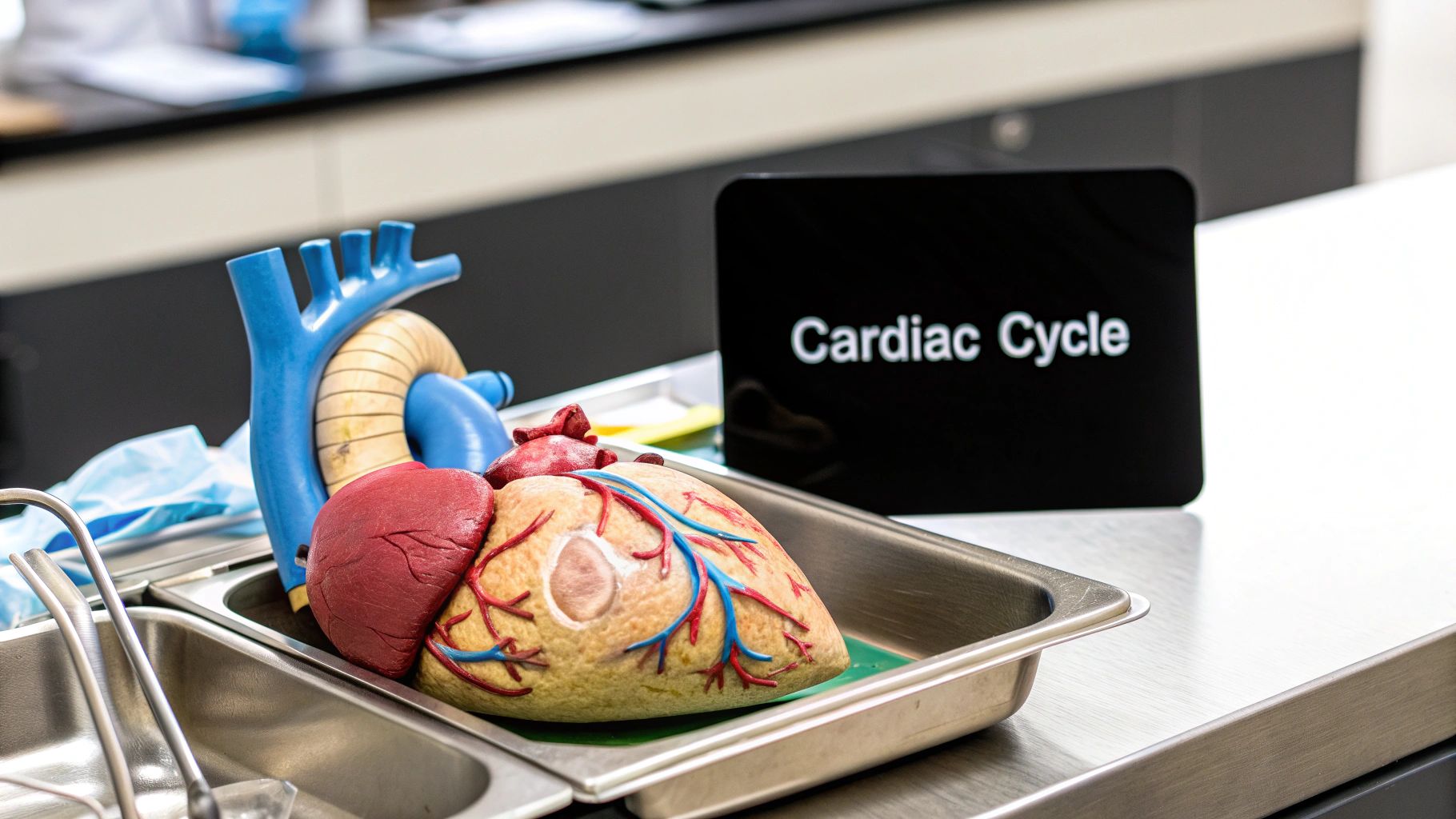
Why It's a High-Yield Topic
The AAMC uses research passages to assess your scientific inquiry and reasoning skills, not just content knowledge. Questions will ask you to identify flaws in a study, suggest improvements, or draw appropriate conclusions from presented data. For example, you might analyze a clinical trial for a new antidepressant and be asked to identify the control group, potential placebo effects, or whether the results can be generalized to a broader population. Your ability to spot the difference between correlation and causation is a critical skill that distinguishes high-scorers.
Actionable Study Strategies
To master this topic, you must apply the concepts to new scenarios. These medical exam study tips can also help refine your overall approach.
- Deconstruct Every Passage: For every P/S passage you practice, actively identify the independent and dependent variables, the control and experimental groups, and any potential confounding variables. Ask yourself: "Does the conclusion logically follow from the results?"
- Focus on Validity and Reliability: Understand the threats to internal validity (e.g., selection bias, attrition) and external validity (e.g., sampling bias). Know that reliability refers to the consistency of a measure, while validity refers to its accuracy.
- Master Statistical Significance: Learn what a p-value represents and how to interpret confidence intervals. You won't need to perform complex calculations, but you must understand what statistical significance implies about the study's results.
- Understand Study Types: A solid grasp of different research methodologies is crucial, including distinguishing between qualitative and quantitative research. Be able to identify and compare experimental studies, correlational studies, longitudinal studies, and case studies, understanding the strengths and weaknesses of each.
10. Optics and Vision
While often viewed as a pure physics topic, Optics and Vision is a classic example of the interdisciplinary nature of the MCAT. This subject bridges the gap between the Chemical and Physical Foundations of Biological Systems and the Biological and Biochemical Foundations of Living Systems sections. Success here requires not just solving for image distance but also understanding how these physical principles apply to the human eye, making it a critical one of the MCAT high yield topics.
A solid foundation in geometric optics, including the behavior of converging and diverging lenses, is the starting point. This knowledge is then directly applied to the anatomy of the eye, treating it as a complex optical system. Understanding how the cornea and lens work together to focus light onto the retina is fundamental to grasping both normal vision and common defects.
Why It's a High-Yield Topic
Questions on optics frequently integrate physics calculations with biological applications. The AAMC loves to test your ability to diagnose a vision problem like myopia (nearsightedness) and then determine the correct type of lens (diverging) and its required power in diopters to fix it. This requires you to seamlessly move between concepts: from the anatomy of an elongated eyeball causing the focal point to be in front of the retina, to the physics of a concave lens spreading out light rays to move that focal point back. This two-step reasoning is a hallmark of high-yield MCAT questions.
Actionable Study Strategies
To master optics, you must connect the equations to their real-world biological applications.
- Master the Sign Conventions: The thin lens equation (1/f = 1/o + 1/i) is useless without a perfect grasp of sign conventions. Create a simple chart: Converging lenses have a positive (+) focal length, while diverging lenses have a negative (-) one. A real image has a positive (+) image distance, while a virtual image has a negative (-) one. Drill this until it is second nature.
- Ray Tracing is Your Friend: Don't just rely on equations. Practice drawing ray diagrams for both converging and diverging lenses. Visually tracing the paths of light helps build an intuitive understanding of where an image will form (real vs. virtual, inverted vs. upright) and solidifies the concepts behind the formulas.
- Think Like an Optometrist: Frame your study around clinical scenarios. For hyperopia (farsightedness), ask: "Is the eyeball too short or the lens too weak? Where does the image form? What kind of lens (converging) is needed to increase the focusing power and correct it?" This approach makes the physics less abstract.
- Connect Power and Focal Length: Lens power (P), measured in diopters, is simply the inverse of the focal length in meters (P = 1/f). Practice converting between these units, as MCAT questions often provide prescriptions in diopters and require you to use the focal length in the thin lens equation.
High-Yield MCAT Topics Comparison
| Topic | Implementation Complexity 🔄 | Resource Requirements ⚡ | Expected Outcomes 📊 | Ideal Use Cases 💡 | Key Advantages ⭐ |
|---|---|---|---|---|---|
| Amino Acids and Protein Structure | Moderate – requires memorization and 3D visualization | Medium – structural models or visualization tools helpful | Deep understanding of protein function and enzyme activity | Biochemistry fundamentals, enzyme kinetics, metabolism | Fundamental for biological processes, links biochem to organic chem |
| Enzyme Kinetics and Inhibition | High – involves mathematical calculations and kinetic plots | Low-medium – requires graphing tools and practice | Ability to analyze enzyme activity, inhibition effects | Drug action, metabolism, pharmacology | Quantitative, predictable question types, connects to pharmacology |
| Cellular Respiration and ATP Production | Moderate – memorization plus pathway integration | Medium – diagrams and pathway charts useful | Comprehensive view of energy metabolism and ATP yield | Metabolism, exercise physiology, mitochondrial diseases | Central metabolic pathway, links multi-step processes clearly |
| DNA Replication and Repair | Moderate to High – multiple enzymes and strand processes | Medium – diagrams beneficial | Understanding genetics, mutation, and repair mechanisms | Genetics, cancer biology, PCR technique | Fundamental to inheritance, clear process with specific enzymes |
| Acid-Base Chemistry and Henderson-Hasselbalch | Moderate – quantitative with logarithmic math | Low – calculator for practice recommended | Predict acid-base behavior and buffer capacity | Blood pH regulation, protein ionization, lab techniques | Highly quantitative, applicable to biological systems |
| Mendelian Genetics and Inheritance Patterns | Moderate – probability and pattern recognition | Low-medium – problem-solving tools | Predict inheritance patterns and genetic probabilities | Human genetics, disease inheritance, population genetics | Clear mathematical relationships, foundation for genetics |
| Thermodynamics and Free Energy | High – abstract concepts with math complexity | Low-medium – conceptual understanding required | Predict reaction spontaneity and energy changes | Metabolic regulation, reaction prediction | Fundamental principles linking chemistry and biology |
| Circulatory System and Cardiac Cycle | Moderate – anatomical and physiological integration | Low – diagrams and models helpful | Understand heart function and blood flow dynamics | Cardiovascular health, exercise physiology | Clear physiological sequence, disease relevance |
| Psychological Research Methods and Statistics | Moderate – understanding designs and stats | Low-medium – software/tools aid interpretation | Evaluate scientific studies and data validity | Psychology, social sciences, experimental design | Critical for evidence-based reasoning across sciences |
| Optics and Vision | Moderate – mathematical and spatial visualization | Low – diagram practice essential | Predict image formation and correct vision defects | Physics, vision correction, optical devices | Clear math relations, direct application to biology and physics |
Turning High-Yield Knowledge into High-Scoring Performance
You’ve just navigated a curated tour of some of the most essential MCAT high yield topics, from the molecular intricacies of amino acids to the complex mechanics of vision. It's easy to feel overwhelmed by the sheer volume of content the MCAT covers. However, the true power of a high-yield approach isn't just about what you study; it's about how you integrate that knowledge and apply it under pressure.
Merely memorizing the names of 20 amino acids or the steps of the cardiac cycle will not be enough to conquer the MCAT. The AAMC designs questions to test your ability to think critically and connect disparate concepts. A high-yield topic is valuable because it serves as a central hub, linking to dozens of other concepts across different disciplines.
Key Insight: True mastery of high-yield content means you can see the connections. You understand how enzyme kinetics (a Bio/Biochem topic) is fundamentally governed by thermodynamics (a Chem/Phys topic), and how a disruption in cellular respiration can manifest in the physiological symptoms discussed in a passage about the circulatory system.
From Concepts to Confidence: Your Actionable Next Steps
Mastering these core areas provides the foundational framework upon which you can hang less frequent, more specific details. Think of it as building the strong trunk and main branches of a tree before worrying about every single leaf. A solid understanding of these pillars ensures you can reason through unfamiliar problems, a skill that is far more valuable than rote memorization.
To translate this list into a tangible score increase, consider these immediate actions:
Thematic Review Sessions: Instead of studying subjects in isolation, create review sessions built around these high-yield themes. For example, dedicate a session to "Energy" and pull in concepts from thermodynamics, cellular respiration, ATP, and even the energy of photons in optics. This mimics the MCAT's interdisciplinary nature.
Concept Mapping: For each of the ten topics listed, create a visual concept map. Start with the central idea, like "Enzyme Kinetics," and branch out to connect it to related terms like Vmax, Km, competitive inhibition, protein structure, and pH effects. This active recall technique solidifies relationships between ideas.
Targeted Question Drilling: Use a question bank to specifically target these MCAT high yield topics. After completing a block of questions on acid-base chemistry, don’t just check your answers. For every question you got wrong and right, articulate why the correct answer is correct and why the distractors are incorrect. This deepens your understanding far more than passively reading explanations.
The Bigger Picture: Why This Strategy Works
Adopting a high-yield strategy is fundamentally about efficient and effective preparation. Your study time is a finite, precious resource. By concentrating your initial efforts on the concepts that offer the greatest return on investment, you build a versatile mental toolkit. This approach frees up cognitive bandwidth during the exam, allowing you to tackle complex passages and novel scenarios with confidence rather than panic.
The goal is not just to recognize a familiar term on test day. The goal is to see a question about an experimental research design and immediately access your mental framework for statistics and ethics. It's about reading a dense passage on a genetic disorder and confidently applying your knowledge of Mendelian patterns and DNA repair mechanisms to predict outcomes. By truly mastering these foundational pillars, you are not just preparing to pass the MCAT; you are preparing to excel and demonstrate the critical thinking skills of a future physician.
Ready to transform your understanding of MCAT high yield topics into a top-tier score? Ace Med Boards offers a comprehensive suite of resources, including targeted question banks and in-depth video explanations designed to help you master these essential concepts. Move beyond simple memorization and start building the deep, integrated knowledge you need to succeed by visiting Ace Med Boards today.
